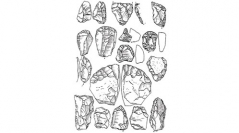

 Comptes Rendus Palevol
5 (1-2) - Pages 183-192
Comptes Rendus Palevol
5 (1-2) - Pages 183-192In Europe, 14C dating provides various histories about the relationship between Neanderthals and the oldest Modern Humans who inhabited Europe. ‘Transitional cultures’ have been identified these latest years in lithic assemblages according to the technical behaviour (Chatelperronian, Uluzzian, Bohunician, Szeletian...). According to the geographical areas, they could be the result of a local change of the Neanderthal groups or the proof of external influences. Some technical characters are linked to the Middle Palaeolithic behaviour (flake knapping, side-scrapers, denticulates, notches), while others are considered as Modern Human characteristics (blade knapping, Upper Palaeolithic tools, ‘ parure ’, bone tools). Actually, Neanderthals could be the authors of these assemblages. In the European early periods, they show similar abilities and a great variability in the behaviours depending on the areas, as for example the blade debitage observed in Europe around 250 ka or the ochre use. The observation of an east–west gradient of the Neanderthal characters (skull height, forehead width...) shows a Neanderthal speciation-type ring species with modern humans. Consequently, some ‘transitional assemblages’ as the Chatelperonnian or the Uluzzian can be interpreted as character displacements when modern humans arrived in western Europe. Among Hominids, selection could be sometimes active on the behaviours and not only on the anatomical morphology. This new hypothesis on the systematic status of the Neanderthals is on half-way between the multi-regional model and the ‘African Eve’ model. It takes arguments both from each model. This kind of speciation leads to think about the Hennigian species concept and the use of the cladistic method in palaeoanthropology.
Chatelperronian, Uluzzian, Bohunician, Szeletian, Ring species, character displacement, Hennigian species